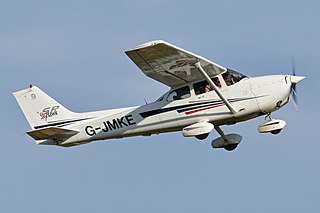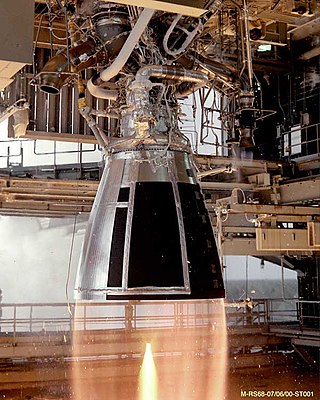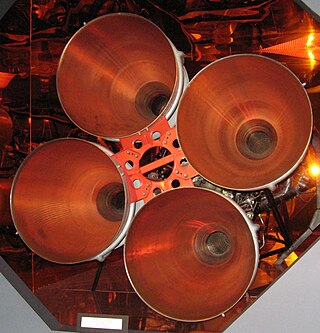Related Research Articles

An aircraft is a vehicle that is able to fly by gaining support from the air. It counters the force of gravity by using either static lift or the dynamic lift of an airfoil, or, in a few cases, direct downward thrust from its engines. Common examples of aircraft include airplanes, helicopters, airships, gliders, paramotors, and hot air balloons.

A jet engine is a type of reaction engine, discharging a fast-moving jet of heated gas that generates thrust by jet propulsion. While this broad definition may include rocket, water jet, and hybrid propulsion, the term jet engine typically refers to an internal combustion air-breathing jet engine such as a turbojet, turbofan, ramjet, or pulse jet. In general, jet engines are internal combustion engines.

A rocket is a vehicle that uses jet propulsion to accelerate without using the surrounding air. A rocket engine produces thrust by reaction to exhaust expelled at high speed. Rocket engines work entirely from propellant carried within the vehicle; therefore a rocket can fly in the vacuum of space. Rockets work more efficiently in a vacuum and incur a loss of thrust due to the opposing pressure of the atmosphere.

A ramjet, or athodyd, is a form of airbreathing jet engine that uses the forward motion of the engine to take in air for combustion that produces jet thrust. Since it produces no thrust when stationary ramjet-powered vehicles require an assisted take-off like a rocket assist to accelerate it to a speed where it begins to produce thrust. Ramjets work most efficiently at supersonic speeds around Mach 3 and can operate up to speeds of Mach 6.

Spacecraft propulsion is any method used to accelerate spacecraft and artificial satellites. In-space propulsion exclusively deals with propulsion systems used in the vacuum of space and should not be confused with space launch or atmospheric entry.

A solid-propellant rocket or solid rocket is a rocket with a rocket engine that uses solid propellants (fuel/oxidizer). The earliest rockets were solid-fuel rockets powered by gunpowder; they were used in warfare by the Chinese, Persians, Mongols, and Indians as early as the 13th century.

Robert Hutchings Goddard was an American engineer, professor, physicist, and inventor who is credited with creating and building the world's first liquid-fueled rocket. Goddard successfully launched his rocket on March 16, 1926, which ushered in an era of space flight and innovation. He and his team launched 34 rockets between 1926 and 1941, achieving altitudes as high as 2.6 km (1.6 mi) and speeds as fast as 885 km/h (550 mph).
A pulse detonation engine (PDE) is a type of propulsion system that uses detonation waves to combust the fuel and oxidizer mixture. The engine is pulsed because the mixture must be renewed in the combustion chamber between each detonation wave and the next. Theoretically, a PDE can operate from subsonic up to a hypersonic flight speed of roughly Mach 5. An ideal PDE design can have a thermodynamic efficiency higher than other designs like turbojets and turbofans because a detonation wave rapidly compresses the mixture and adds heat at constant volume. Consequently, moving parts like compressor spools are not necessarily required in the engine, which could significantly reduce overall weight and cost. PDEs have been considered for propulsion since 1940. Key issues for further development include fast and efficient mixing of the fuel and oxidizer, the prevention of autoignition, and integration with an inlet and nozzle.

A rocket engine uses stored rocket propellants as the reaction mass for forming a high-speed propulsive jet of fluid, usually high-temperature gas. Rocket engines are reaction engines, producing thrust by ejecting mass rearward, in accordance with Newton's third law. Most rocket engines use the combustion of reactive chemicals to supply the necessary energy, but non-combusting forms such as cold gas thrusters and nuclear thermal rockets also exist. Vehicles propelled by rocket engines are commonly called rockets. Rocket vehicles carry their own oxidiser, unlike most combustion engines, so rocket engines can be used in a vacuum to propel spacecraft and ballistic missiles.

A liquid-propellant rocket or liquid rocket utilizes a rocket engine that uses liquid propellants. Gaseous propellants may also be used but are not common because of their low density and difficulty with common pumping methods. Liquids are desirable because they have a reasonably high density and high specific impulse (Isp). This allows the volume of the propellant tanks to be relatively low. The rocket propellants are usually pumped into the combustion chamber with a lightweight centrifugal turbopump, although some aerospace companies have found ways to use electric pumps with batteries, allowing the propellants to be kept under low pressure. This permits the use of low-mass propellant tanks that do not need to resist the high pressures needed to store significant amounts of gasses, resulting in a low mass ratio for the rocket.

A jet pack, rocket belt, or rocket pack is a device worn on the back which uses jets of gas or liquid to propel the wearer through the air. The concept has been present in science fiction for almost a century and became widespread in the 1960s.

A rocket-powered aircraft or rocket plane is an aircraft that uses a rocket engine for propulsion, sometimes in addition to airbreathing jet engines. Rocket planes can achieve much higher speeds than similarly sized jet aircraft, but typically for at most a few minutes of powered operation, followed by a gliding flight. Unhindered by the need for oxygen from the atmosphere, they are suitable for very high-altitude flight. They are also capable of delivering much higher acceleration and shorter takeoffs. Many rocket aircraft may be drop launched from transport planes, as take-off from ground may leave them with insufficient time to reach high altitudes.

Pedro Eleodoro Paulet Mostajo was a Peruvian diplomat and engineer. Some early rocket experts described him as a pioneer in aeronautics, saying that he was the first person to build a liquid-propellant rocket engine and modern rocket propulsion system, but his experiments were never independently verified.

Robert Albert Charles Esnault-Pelterie was a French aircraft designer and spaceflight theorist. He is referred to as being one of the founders of modern rocketry and astronautics, along with the Russian Konstantin Tsiolkovsky, the Germans Hermann Oberth, Fritz von Opel, Wernher Von Braun and the American Robert H. Goddard.

Rocket artillery is artillery that uses rocket explosives as the projectile. The use of rocket artillery dates back to medieval China where devices such as fire arrows were used. Fire arrows were also used in multiple launch systems and transported via carts. The first true rocket artillery was developed in India by the Kingdom of Mysore. In the late nineteenth century, due to improvements in the power and range of conventional artillery, the use of early military rockets declined; they were finally used on a small scale by both sides during the American Civil War. Modern rocket artillery was first employed during World War II, in the form of the German Nebelwerfer family of rocket ordnance designs, Soviet Katyusha-series and numerous other systems employed on a smaller scale by the Western allies and Japan. In modern use, the rockets are often guided by an internal guiding system or GPS in order to maintain accuracy.

Spacecraft electric propulsion is a type of spacecraft propulsion technique that uses electrostatic or electromagnetic fields to accelerate mass to high speed and thus generate thrust to modify the velocity of a spacecraft in orbit. The propulsion system is controlled by power electronics.

The pintle injector is a type of propellant injector for a bipropellant rocket engine. Like any other injector, its purpose is to ensure appropriate flow rate and intermixing of the propellants as they are forcibly injected under high pressure into the combustion chamber, so that an efficient and controlled combustion process can happen.
Luigi Gussalli (1885–1950), engineer and inventor, was a pioneer of motor cars. He turned to astronautics in the 1920s, corresponding with world leaders in this field, such as Oberth and Goddard and exchanging with them theories on interplanetary flight and its prospects. He developed a special double-reaction engine, wrote extensively on multi-stage rockets and published two books on space travel. The first one, in 1923, described a space flight to the Moon, the second one, written in 1946, is even more astonishing in its theme: “Interplanetary travels by means of solar radiations”.

Soviet rocketry commenced in 1921 with development of Solid-fuel rockets, which resulted in the development of the Katyusha rocket launcher. Rocket scientists and engineers, particularly Valentin Glushko and Sergei Korolev, contributed to the development of Liquid-fuel rockets, which were first used for fighter aircraft and later for ballistic missiles, and space exploration. Progress was greatly augmented by the reverse engineering of Nazi German technology captured by westward-moving troops during the final days of World War II and the immediate period following, though after 1947 their influence was marginal. Developments continued in the 1950s with a variety of ICBMs and resulted in the launch of Sputnik 1 in 1957, the first artificial Earth satellite ever launched.
Gadicharla V.R. Rao , D.Sc. was an American aerospace engineer of Indian origin who worked in the jet engine and rocket propulsion fields. Rao worked for General Electric in their Gas Turbine Division department and was a research scientist at Marquardt Aircraft, before working for Rocketdyne, where he designed the optimum thrust nozzle. Often referred to as the "Rao's nozzle", it is part of the standard design for rocket engines. The Rao Nozzle is used currently in rocket, missile, and satellite control systems worldwide. It is taught in universities that offer Aerospace Engineering, including Massachusetts Institute of Technology (MIT), California Institute of Technology (Caltech), and Georgia Institute of Technology.
References
- 1 2 3 4 5 6 7 8 9 Healy, Roy. "Roy Healy Papers." https://collections.si.edu/search/detail/ead_collection:sova-nasm-2017-0034?q=%22roy+healy%22&record=6&hlterm=%26quot%3Broy%2Bhealy%26quot%3B . Web. 11/6/22
- ↑ Wall Street Journal Staff Reporter. "Rocket with 1,500,000 Pounds Thrust Called Possibility in Year: North American Aviation Aide Says Thor, Jupiter Components being used in Army Project." Wall Street Journal, Sep 17, 1958, Web. 11/6/22
- ↑ "Lawrence Heads Rocket Society." The New York Times, May 20, 1946, Web. 11/6/22
- ↑ "American Rocket Society News". Jet Propulsion. 24 (6): 3. November 1954 – via ARC.
- ↑ "ROCKETS FORESEEN AS MAIL CARRIERS: Their use on Trans-U.S. Runs in a Few Years Predicted by H. F. Guggenheim COULD CARRY CARGO Low Fuel Cost Held Factor --13 Specialists in Field Honored at Chicago." The New York Times, Nov 17 1955, Web. 11/6/22
- ↑ Lal, G. B. "Rocket Device Tests Planned for War Uses." The Washington Post, June 15, 1941, Web. 11/6/22
- 1 2 Healy, Roy (November 1941). "Thrust of Powder Rocket Charges: Commercial Types Tested". Astronautics. 11 (51): 6 – via ARC.
- 1 2 Healy, Roy (March 1944). "The Nazi Rocket Threat: Giant Projectiles Awaiting Invasion". Astronautics. 14 (57): 4 – via ARC.
- 1 2 Healy, Roy (December 1943). "Nazi Rocket Weapons: Jet Power Widely Used by Germany". Astronautics. 13 (56): 3 – via ARC.
- 1 2 Healy, Roy (October 1942). "The Black Powder Rocket Charge: Its Military Uses". Astronautics. 12 (53): 3 – via ARC.